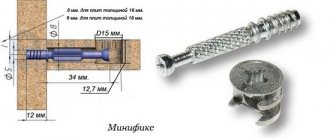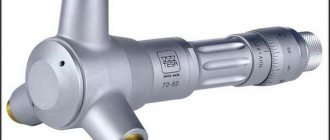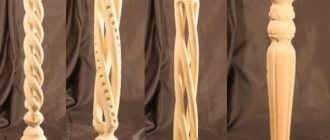Inserting a lock into a wooden interior or entrance door is one of the most critical processes when installing this enclosing structure. The outdated technique of gouging out grooves with a chisel and hammer is a thing of the past. Today, professionals actively use special electrical appliances – milling cutters. To achieve the expected result, you need to know exactly which router to cut the lock into the door.
Mortise a lock using a hand router
Types of milling cutters
To insert locks into wooden door panels, hand-held milling cutters are used, which are fixed at the end of the structural element and the material is sampled strictly in the specified location. Milling cutters that are widely available are divided into the following basic types:
- Vertical, or submersible, is the most popular tool - the cutter is positioned strictly perpendicular to the plane being processed, the immersion depth is determined by the master by applying force to the spring mechanism on which the device is fixed.
Vertical router
- Edge, or edging - miniature cutters, as well as the high-precision movement of the device, allow you to perform filigree work on processing the edges of a wooden door leaf with an accuracy of tenths of a millimeter.
- Combined - one of the most popular devices among professionals - the design combines two types of milling cutters - vertical and edge, which allows for complex processing of the blade when inserting locks of any complexity.
- Special-purpose, dowel, lamellar - purely professional machines that are designed to perform any one technological operation.
Edge router
Residents should take into account that the purchase of milling cutters with a set of working parts does not guarantee high quality of blade processing and accuracy of inserting locks, since the master is required to comply with the technological map and have extensive experience working with the equipment.
Classification of cutters
When purchasing a router, you also need to additionally purchase cutting tools (cutters) with the required edge and design. These removable parts are divided into several categories:
- Grooved - designed for making grooves, gutters and other extended or deep recesses, they are classified into several types:
- Structural – classic cutouts allow you to make even cuts with orthogonal edges.
- Straight - perform straight cuts.
Slot cutters
- Fillet - used for making deep holes.
- Edge - ideal for cutting complex grooves for lock plates, or for forming artistic patterns on the canvas. Classification:
- Straight - allow you to process a straight edge on the canvas.
- Disc – designed for sampling and processing the rebate plane.
- Horizontal - an indispensable tool for finishing each edge before installing the lock in the resulting groove.
- Curved - a thin working body allows you to process any type of surface, regardless of its shape and dimensions.
Edge cutters
- Figurative - designed for finishing the edges or faces of a sample of the main volume of wood, suitable for any curved surface. Classification:
- Horizontal - supplied in the form of a disk, designed for finishing grooves of small depth.
- Vertical - have a small diameter and large depth, easily penetrate into the deepest grooves for finishing the edge.
- One-sided - allow you to process the plane only in the contact area.
- Double-sided - a universal tool with a cutting edge along the entire perimeter of the cutter.
Figurine cutters
Experts recommend purchasing cutters from well-known manufacturers, made of alloy steel with high-quality soldering and laser sharpening. All high-tech devices from reliable suppliers are supplied with a quality certificate indicating the warranty period for trouble-free operation.
Nuances of choice
When choosing tools and cutters, you should pay attention to several points. First of all, it is necessary to consider the frequency of use of the router. If the amount of work is small, you can choose inexpensive models
If you purchase a tool for frequent or professional use, it is best to take a closer look at more expensive and branded models. Milling cutters are often sold in sets that are designed for specific types of work.
If the amount of work is small, you can choose inexpensive models. If you purchase a tool for frequent or professional use, it is best to take a closer look at more expensive and branded models. Often, cutters are sold in sets that are designed for specific types of work.
Regarding the selection of cutters, the following factors must be taken into account:
- the material from which the equipment is made;
- soldering quality;
- thermal strength;
- type of connection between the shank and the cutting part;
- size compatibility between tool and cutter;
- shank size;
- blade position.
When choosing equipment for a tool, you should inspect the cutters to check the quality of soldering and eliminate defects. The soldering of the equipment must be made so that the router does not lose its longitudinal stability during long-term processing
This is especially important if you have to work with hard wood.
Let's pay attention to the solder. The highest quality brands are PSr40 or PSr37.5, which contain increased levels of copper and silver. Additions in other brands usually contain nickel, which negatively affects the strength of the connection between the cutting part and the shank
Additions in other brands usually contain nickel, which negatively affects the strength of the connection between the cutting part and the shank.
The characteristics of the base metal are divided into 2 types:
- designation HM - classified as high-speed, used in working with soft wood, but can be used in processing aluminum;
- designation HSS - made of hard metal alloy, used in working with hard wood, bronze, metal and plastic.
If possible, it is better to choose products with the HSS designation. They are more expensive than high-speed cutters, but the characteristics of such cutters are much better. The connection between the cutting part and the shank should under no circumstances be made by welding.
A fairly simple and important detail that you can forget about when checking is the dimensions. The equipment must be suitable in size for the tool. In the set, the router is equipped with collets or bushings with which the cutter is secured - the size of the selected equipment depends on their parameters. The size is indicated in millimeters or inches. The blades can be positioned at an angle or parallel.
This leads to physical difficulties during the work process, and the surface will need to be sanded. It follows from this that it is best to use equipment with vertical blades for preliminary work, and use inclined blades at the final stages of work. A good, high-quality cutter will not cause problems in operation and will not become dull during the first uses. As for choosing a manufacturer's brand, it is best not to purchase cutters from unknown manufacturers. Beginners and amateurs should consult with the seller or read reviews of brands before making a purchase.
How to choose the right tool
When purchasing a router for inserting a lock into wooden door leaves, you need to take into account a number of important nuances:
- The natural material is easy to process, which is why the master does not need a high-power machine. The average equipment performance is no more than 2.5 - 3.5 kW.
Household hand router
- To avoid complex manual reworking of the grooves after sampling the material with a milling cutter, it is necessary to purchase in advance a machine with the required stroke amplitude of the working head. Experts recommend choosing this parameter with a slight margin.
- The weight of the device should be such that the master can easily move the router with both hands.
- The standard electrical cord must be covered with elastic rubber insulation and be of sufficient length for comfortable use.
- The functionality and number of modes of the router must fully satisfy the operational requirements for it.
Operating modes of power tools
- The power tool must be equipped with a removable working head to allow quick replacement of cutters with different diameters and characteristics.
- The device must provide a complete, unobstructed view of the plane being processed.
One of the most important parameters for choosing a reliable car is the popularity of the brand, the year the company was founded, as well as the presence of positive reviews about the brand’s products on the Internet.
What auxiliary tools are needed to select grooves for locks?
In addition to the router, the home craftsman will need a number of additional hand tools:
- To mark the door leaf:
- Laser or standard tape measure with steel blade.
- High precision carpentry corner.
- Construction metal ruler with a blade length of 1000 mm.
- A simple pencil or marker.
Markup Tools
- To fix the door leaf:
- Place a soft layer on the workbench or floor to prevent damage to the end of the door leaf during operation.
- A slipway for fixing the product in the desired position.
- Clamps for clamping the door leaf after installation on the slipway.
Clamps for fixing the canvas
- To select material for installing a lock:
- 2 or 3 replaceable heads with collets for the router.
- A set of cutters of all categories described above.
- To refine the sample after cutting with a router:
Set of cutters
- A chisel with a narrow cutting edge.
- A hammer with a hammer weight of up to 300 - 500 g.
- A file with a coarse abrasive.
- Sandpaper for finishing grooves.
- To fix the lock in the body of the canvas:
- Set of self-tapping screws.
- Drill with a thin drill bit for marking holes for self-tapping screws.
- Screwdriver with variable rotation speed and a set of bits.
- A hand-held slotted or Phillips screwdriver for tightening self-tapping screws.
Screwdriver with a set of bits
All tools must be of high quality, well sharpened, free of dirt and oil stains, and ready for work.
How to properly set up a router
Before you start working with the router, you need to prepare it for work by performing the following steps:
- The router is mounted on a frame, which is fixed to the plane of the door leaf using clamping clamps.
- The main pin, which is responsible for moving the device in the frame, is loosened manually.
Setting up the router
- The required cutter is inserted into the working head of the milling cutter, which is clamped on the collet.
- The cutter with the working head is carefully lowered to the required depth, depending on the type of plane being processed.
- On the scale responsible for the position of the cutter and the depth of the excavation, the position “0” is set.
- The bed clamping screw is firmly fixed together with the router in the selected position.
Router bed position
One of the most important preparatory stages for work is choosing the number of revolutions of rotation of the cutter. This parameter is determined individually, depending on the type of wood. For pine, 2 - 3 thousand revolutions per minute may be sufficient, and for oak or teak, the rotation speed must be doubled.
Conductor for inserting locks Gidmaster pitfalls
Attracts with its affordable price compared to Virutex. From 10 to 12 thousand rubles. However, the conductor is not universal. Used only as a template for inserting locks.
Moreover, all work will have to be done with a drill. It is extremely inconvenient, the speed is too low, you can damage the door - you often end up with chips and torn edges on the door. Especially if it is covered with enamel.
- An obvious drawback is that it is difficult to set the size correctly.
- Works only with cutters with threads on the collet.
- It is impossible to embed hinges, strikers and crossbars.
Preparing the door leaf
Before starting work, after debugging the router and installing the required working element, it is necessary to prepare the door leaf for work. To do this, you will need to perform a number of steps in accordance with the following algorithm:
- The canvas must be freed from old locks, handles and hinges.
- The best solution would be to install the product to be processed on the opposite end plane.
- Before starting milling, it is recommended to secure the door with clamps or in a vice.
Fixing the door leaf
- Considering that the router has a mass of 3 kg or more, before starting work it is recommended to install the end of the door to be processed so that the router is in a horizontal position and lowers partially under the influence of its own weight.
After fixing the door, it is recommended to apply force to it to check that the position remains unchanged. If the blade becomes skewed or falls during milling, the working element can cause irreparable damage to the wood.
Installation
Having screwed one part of the hinge to the door leaf with self-tapping screws, proceed to inserting the other part into the hinge beam. Different masters carry out this stage in different ways.
- First way . Mark the location of the hinge on the box until it is inserted into the opening. To do this, place it on the floor, place the door leaf inside and, taking into account the upper gap of 3 mm, mark the location of the hinges.
- Second way . When the box is inserted into the opening, the door is placed against it, placing stops underneath. Align to the desired height, taking into account the upper gap, and mark the loops in this position.
- Third way. Although experienced craftsmen do not shift the loops from the originally made marks during the insertion process, they still measure the location of the cards embedded in the canvas just in case.
- The measurement is taken from the top edge of the fabric to the beginning of both loops. For example, the top edge of the top hinge is located 20 cm from the top edge of the door, and the top edge of the bottom hinge is 170 cm from the top edge of the door.
- Then marks are made on the loop beam for the upper edges of the second parts of the loops. In this case, 3 mm is added to the obtained values for the upper gap. In this case, marks are placed at a distance of 20.3 cm and 170.3 cm, respectively.
- Draw arrows indicating in which direction from the mark to embed the loop. Both arrows will point down, as the top edges of the loops are marked.
- Then the second parts of the loops are cut in according to the same pattern.
- This method is convenient when the master works alone and there is no one to help him hold the canvas for method number 2.
Rules for working with a router
To cut a lock into a wooden door with a router yourself, you must follow all the steps in the following step-by-step instructions:
- The door leaf is fixed in the desired position, in a vice or with clamps.
- The plane to be processed should occupy a horizontal position and be located at a height of no more than 1 - 1.2 m from the floor.
Installing a router on a door leaf
- Before milling begins, the door leaf is marked using a ruler, tape measure, carpenter's corner and a simple pencil.
- To mark places for installing radius pads, it is recommended to use these steel parts as templates.
- The router is fixed above the plane being processed using its own clamps.
- The power tool is set to the required groove depth.
- The device is connected to the network, after which the master performs a sample in strict accordance with the pre-applied markings.
Marking the door before processing
- Upon completion of the work, the router is dismantled, and the master fits the lock into the resulting groove.
- If the dimensions do not match, the edge is refined with small cutters or a well-sharpened chisel with a narrow blade.
- A lock is fixed into the prepared hole, which is subsequently secured with self-tapping screws.
After inserting and installing the lock, you must immediately hang the door on the hinges, and then check the softness of movement and locking of the door panel; if any inconsistencies are detected, it is recommended to correct the position of the lock by additionally modifying the cut in the door with a router.
Instructions for installing hinges in interior doors with your own hands
Author of the article: Alexandra Ivanova March 18, 2021
Door hinges are an important element of an interior door, on which its functional purpose and correct opening/closing depend. The most popular are mortise hinges. By following the instructions and recommendations of experienced craftsmen, you can install them yourself.
Possible errors when working with a router and ways to correct them
When inserting a lock into a wooden door using a router, a home craftsman may encounter a number of difficulties that will lead to negative consequences:
- When checking the functionality of the lock, the holes on the counter plate in the area where the door frame is located do not match - before selecting a groove in the frame, it is recommended to hang the door with the lock already installed and make the markings after the fact.
Cutting the counter plate
- When installing the lock in a pre-prepared groove, a slope is observed relative to the vertical axis - when installing the router on clamps, it is necessary to check that the orthogonal position of the working body is observed in relation to the plane being processed.
- When installing the lock, its free movement and play are observed - if the groove is larger than the dimensions of the bolt of the locking mechanism, it is necessary to install expansion linings of wood or plastic into the body of the sample.
Misalignment of the lock installed in the groove
- When you try to install the lock bolt, the difficulty of inserting it becomes apparent - under no circumstances should you hammer the lock with a hammer, since additional pushing forces can cause cracks to form in the wood. For normal installation, it is recommended to widen the hole with a hand chisel.
- If the cutter does not meet the required depth of the future cutting, it is necessary to prepare the necessary cutting element in advance, or carry out the work in 2 stages, with sequential adjustment of the settings of the manual router.
A finished door with a built-in locking device.
If you follow all the recommendations listed above, a door with a lock embedded in it will serve no less than the period stated by the manufacturer. Before starting milling, the home craftsman is recommended to familiarize himself with master classes from professionals and perform all work in strict accordance with the technological map
Using a template
The procedure in question is also carried out with a special template. You can get it yourself as follows:
- First, the offset of the cutter is measured.
- You can determine the dimensions of the template for insertion using conventional measuring tools.
- 2-3 passes are performed.
- This step produces a finished hole.
After receiving the special element in question, you can embed the hinges using other various tools.
In conclusion, we note that the process of cutting hinges with a router is carried out to obtain a high-quality niche. The features of the tool can significantly speed up the process and reduce the likelihood of serious defects. By using special attachments, you can significantly expand the capabilities of the device.
If you find an error, please select a piece of text and press Ctrl+Enter.











